Network Architecutre of Rural Broadband Internet and Its Power Solution
- Richard Wang
- January 7, 2025
- 7:03 pm

Preface
Rural broadband Internet in various countries has always been a difficult area to build. This is because rural areas have problems such as high construction investment, high operation and maintenance costs, and difficulty in obtaining electricity. The contradiction is that the revenue and ARPU of building networks in these areas are relatively low. These contradictions are intertwined, making it difficult for rural area broadband Internet coverage to be profitable, thus greatly slowing down network construction in these areas. This article attempts to discuss the construction of rural broadband Internet in terms of network architecture and power acquisition.
Table of Contents
1.Key Challenges in Building Rural Broadband Internet
1.1 Lack of Power Supply
Source: World Bank
Large cities around the world are generally covered by 4G/5G and wired Internet. Rural Broadband Internet is generally used in remote villages, small towns, etc. However, paradoxically, these areas often have no electricity coverage. This contradiction is more prominent in rural areas of Africa. Therefore, the first challenge for Rural Broadband Internet coverage is how to obtain electricity.
1.2 The Population Density Is Too Low In Rural Area
Rural broadband Internet is not available in areas with low population density. Therefore, if traditional fiber optic coverage or 4G marco stations are used, the population density will limit the revenue and cost. As a result, various service providers and operators are unwilling to provide such coverage services.
1.3 High Maintenance Cost of the Rural Broadband Internet
The cost of building a site in a rural area is relatively high because it takes into account long-distance transportation, the time cost of engineers going back and forth, and the cost of subsequent on-site maintenance and debugging. Therefore, how to reduce the cost of the entire network operation and maintenance becomes a very important design consideration.
1.5 Environmental Challenges


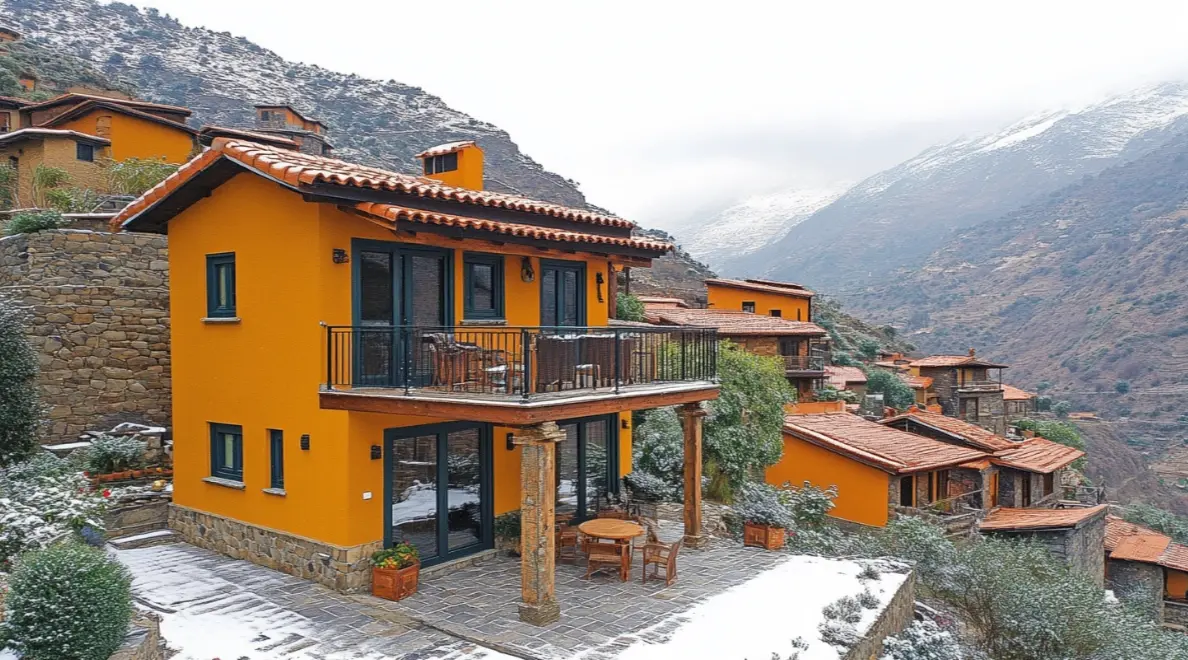

As shown in the figure above, we can see that the environment in the rural area is relatively complex, and these environments will bring many problems to the entire rural broadband Internet network, such as:
- Mountainous areas with frequent climate changes
Because these areas are in mountainous areas, the area changes frequently. Sometimes it rains and then it is sunny. These frequently changing weather conditions can easily cause more serious corrosion to the housing of network equipment systems than in normal climates.
- Areas near the sea
The air humidity in areas near the sea is very high, and the air also has a high salinity. This will accelerate the corrosion of network equipment.
- Low temperature areas
There are some areas with extremely low temperatures in winter. When the temperature is below -10℃, it will greatly affect the operation of the battery. As we mentioned before, these areas often do not have power grids and need to rely on solar systems to work. So how to keep the battery working properly in low temperatures in winter is crucial to the entire network system.
- High humidity areas
There are many areas with high humidity all year round. These areas face the same problems as coastal areas.
This series of environmental challenges will bring additional operation and maintenance costs to the rural broadband Internet network.
2. The Essence of How to Make Rural Broadband Internet Profitable
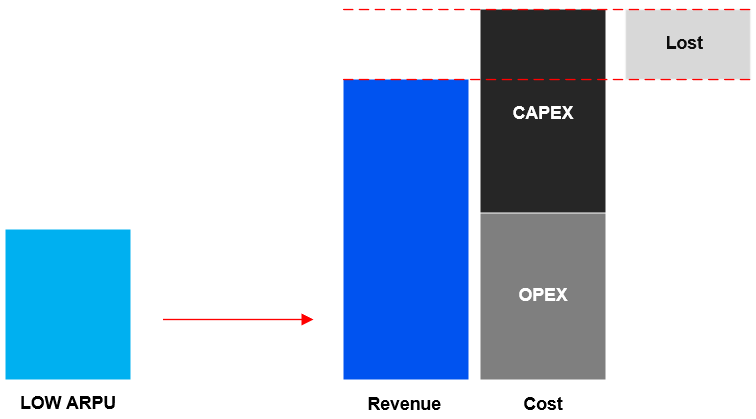
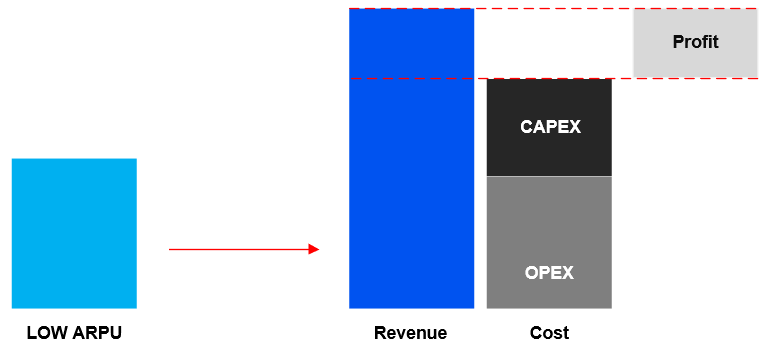
The biggest problem in building rural broadband Internet is the contradiction between revenue and cost. The challenges we mentioned in the first chapter lead to relatively high construction and operation costs in rural areas. However, the contradiction is that the revenue and ARPU in these remote areas are relatively low. Therefore, we need to design the entire network architecture and control the OPEX of the site to achieve profitability of rural broadband Internet.
3. Rural Broadband Internet Based On 4G Small Cell Network Architecture
3.1 4G Small Cell for Rural Broadband Internet
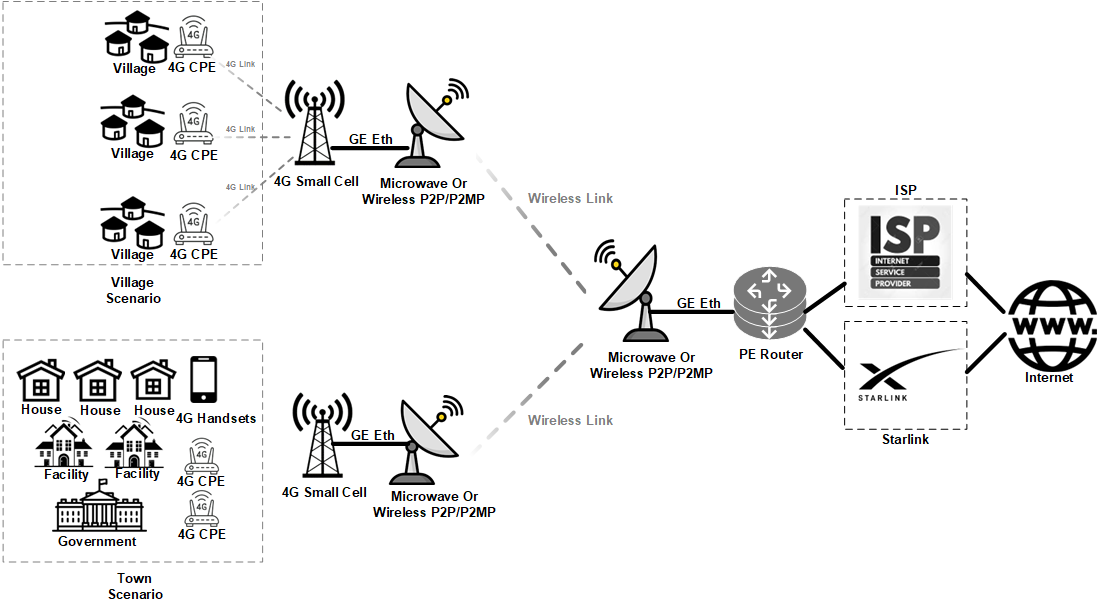
The figure above shows a typical 4G small cell network architecture for implementing Rural Broadband Internet coverage. It can be seen that 4G small cells will serve as the core of the last mile coverage.
ISP and Central Office
Central Office is the core node of the entire network and provides the Internet outlet. In some developed areas, you can choose to rent an ISP as a network outlet, but in fact, this is very difficult in the rural areas of developing countries. Starlink can be a good solution as a fast and cheap solution.
Central Office to Distribution Node
There is no optical fiber between the central office and the distribution node, so microwave and wireless P2P/P2MP are generally used.
Access Node
Access node will be deployed in an area such as a village or town, and 4G small cell will be used to provide coverage.
Final User
Final users have different organizational forms. For example, very small villages can provide 4G CPE in each village to provide network coverage. For the town scenario, the user types will be more diverse. For example, for government, enterprises and various facilities, 4G CPE can be used to provide rural Internet connections, while for houses and individual users, various smart terminals such as phones and pads can be considered for use.
3.2 Advantages of 4G Small Cells
Compared with general 4G macro base stations or fiber networks, the benefits of 4G small cells for last-mile coverage are obvious:
Easier Installation
4G small cell is very easy to install, and does not require a large tower. It can be installed in simple ways such as poles and walls. It does not require a lot of civil work like fiber optic coverage, which greatly reduces the difficulty and cost of installation.
Low CAPEX investment
4G small cells are designed for Rural Broadband Internet with limited capacity, which reduces CAPEX. Generally, the investment cost of a sector ranges from 4000 to 8000 USD.
Low operation and maintenance cost
The maintenance cost of 4G small cell sites is much lower than that of 4G macro base stations.
The above priorities make it possible to build rural broadband Internet using 4G small cells and realize profitability.
3.3 Solar Power or UPS Power for 4G Small Cell
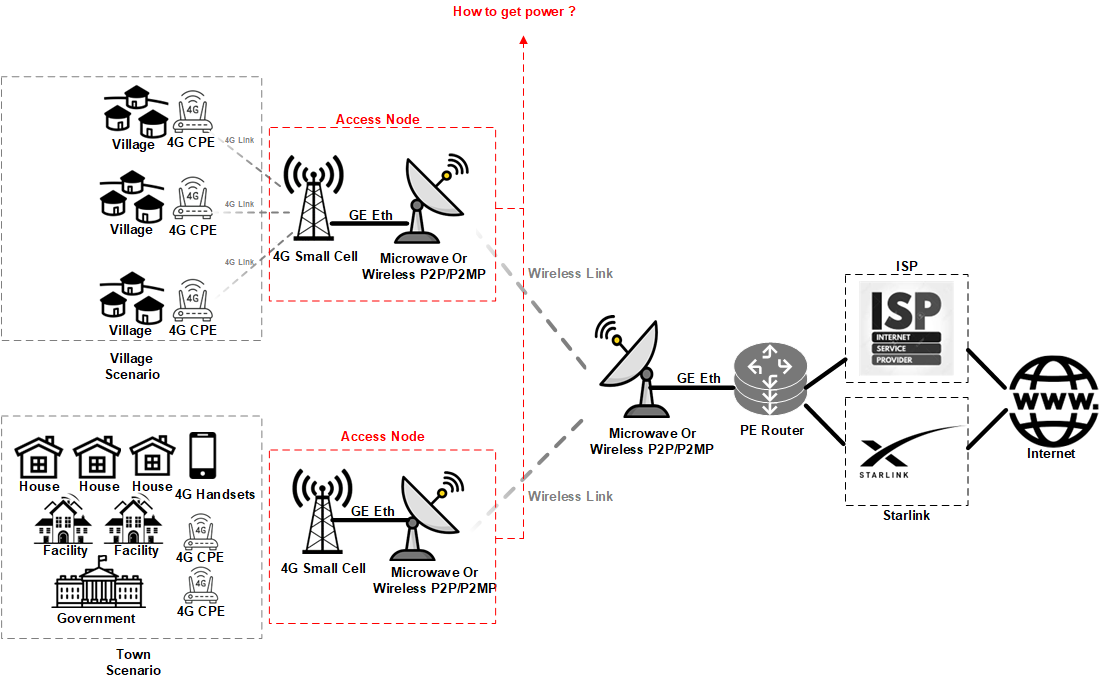
The Access Node is the most difficult location to obtain power. It generally faces two possibilities:
(1) Although power is available but unstable
Power grid instability manifests itself in two forms: the first is that although the power grid is available, it frequently loses power, but the power outages are not long. The second is that there is power only for a few hours a day, and there is no power at other times. Both forms require the design of different UPS systems and batteries to adapt to the scenario, while not configuring them too luxuriously to save CAPEX.
(2) No power grid available
In rural areas, no power grid is available, which is a more common scenario. In this case, we need to properly design the solar power system to match the power of 4G small cells. There are many restrictive factors to consider, such as the local security situation, whether the battery will be stolen, and too large solar panels may cause damage to the site due to strong winds.
However, this is only theoretical. In actual deployment, there are many challenges because the site is located in a rural area:
(1) Equipment transportation is difficult because the site is remote.
Imagine that whether it is a UPS site or a solar site, the equipment is not small according to the traditional solution. Because the site is remote, the cost of transporting the equipment to the site must be considered.
(2) Installation and integration difficulties caused by remote sites
Rural Internet Connections are difficult to install and integrate because they are located in remote areas. If the site installation is too complicated, it will cause engineers to spend too much time in the local area. In addition, the time and cost of commuting will make the entire installation cost too high.
(3) Daily maintenance
As we mentioned in the previous article, the environmental conditions in rural areas are relatively complex. For example, some high-humidity areas in the mountains or areas with frequent climate changes, or some coastal areas will cause rust and other problems to the equipment. This increases the probability of engineers going to the site for maintenance, which greatly increases the maintenance cost of the entire network.
All of the above are contrary to the principles we described in Chapter 2.The Essence of How to Make Rural Broadband Internet Profitable
Therefore, building a 4G Small Cell access node in terms of power is not as simple as imagined.
3.4 Edgeware All in One Soluiton for 4G Small Cell Based On UPS Scenario
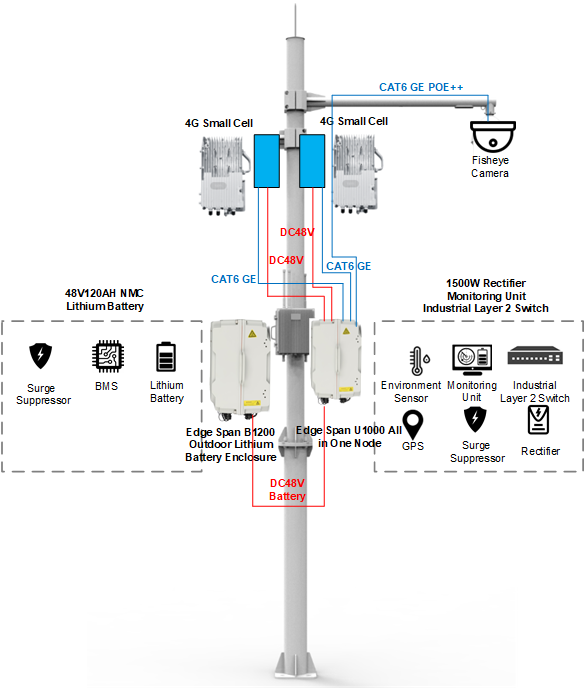
Edgeware can provide customers with an all-in-one UPS system for 4G small cells. We can help customers calculate the size of the UPS system and battery required according to the scenario and make targeted configurations. At the same time, the fiber switch or PoE switch is also integrated. The integrated monitoring and management system helps customers remotely manage the site, thereby reducing the operating costs of the entire network. At the same time, our system is an IP65 level full aluminum enclosure, which is fully adapted to the complex environment of the rural area and is completely maintenance free.
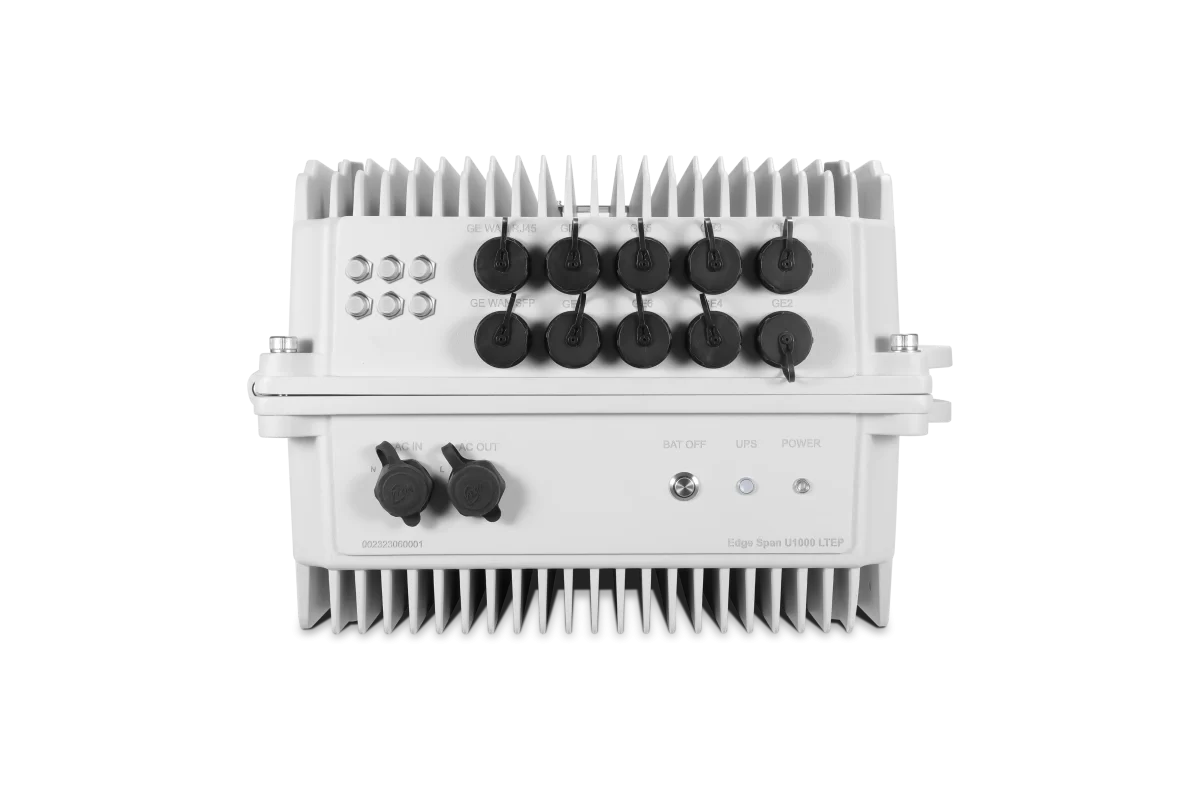
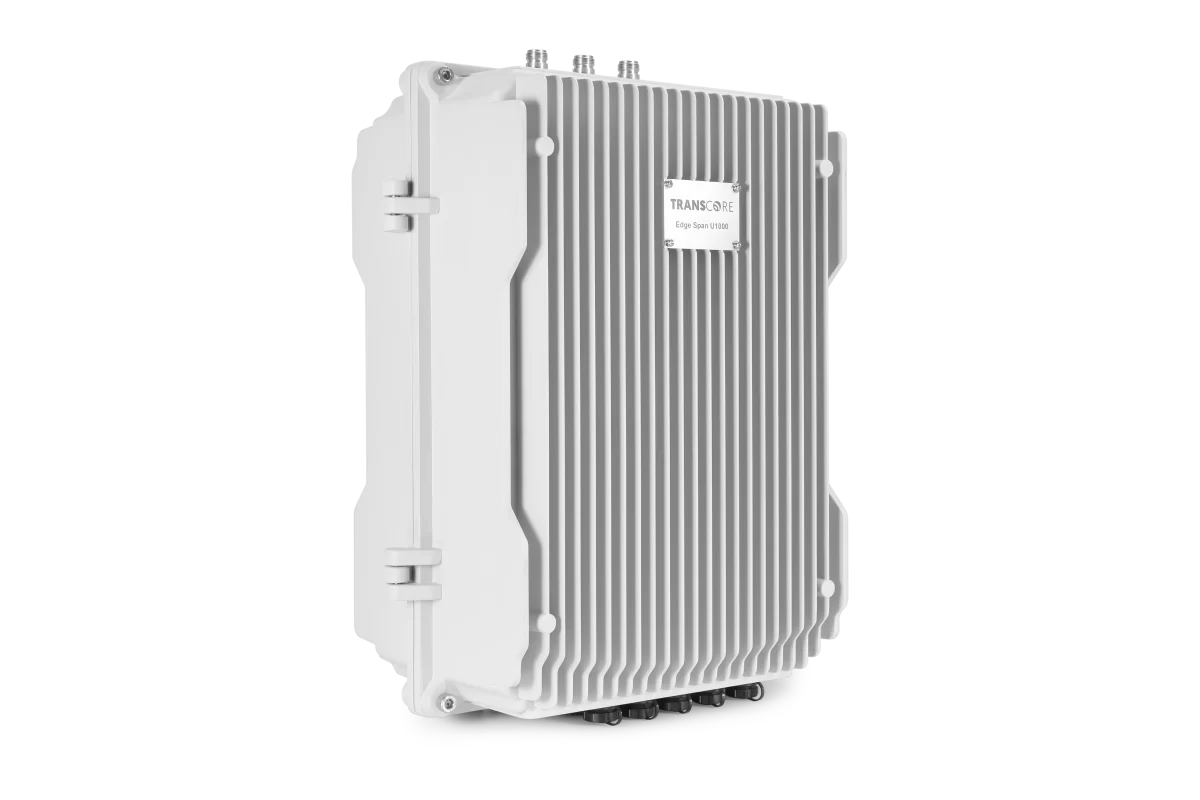
The Edge Span U1000 series has a high overall integration and IP65-level ingress protection. The entire system is built with a cast aluminum housing and is maintenance-free. It can be customized based on the customer’s scenario, please refer to the following link:
3.5 Edgeware All in One Soluiton for 4G Small Cell Based on Solar Power
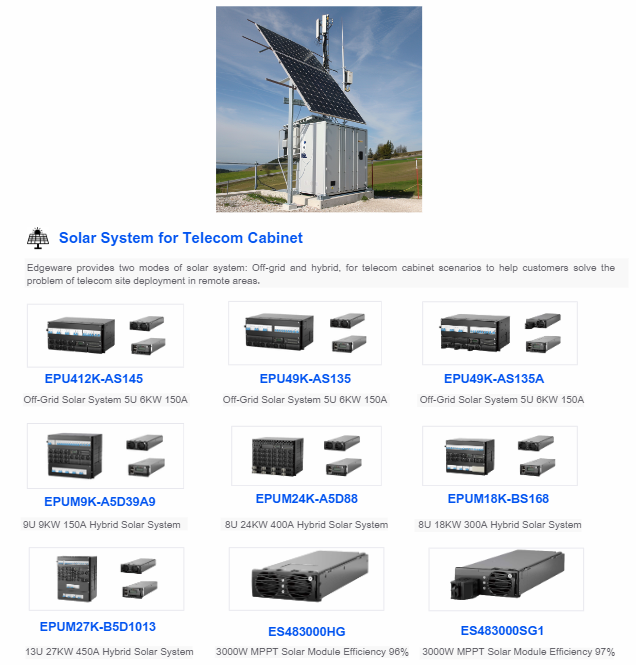
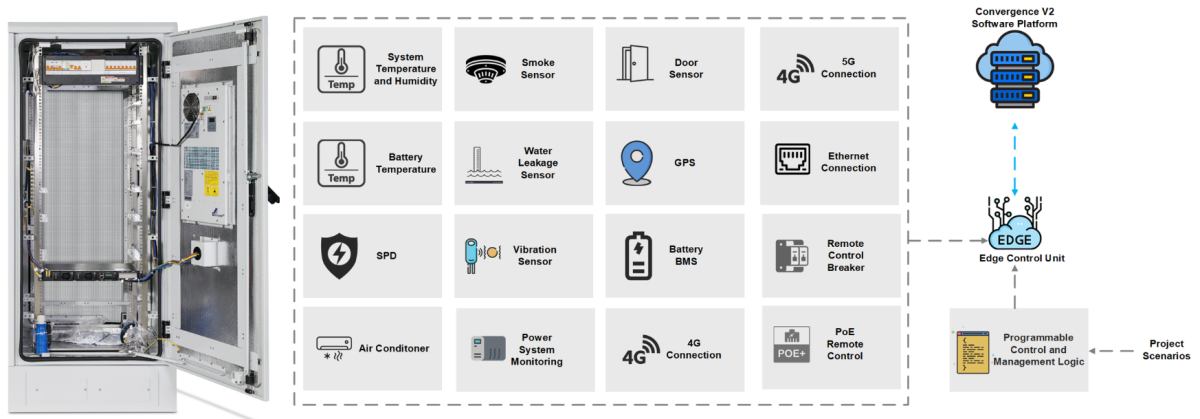
The scale of the solar site in the 4G small cell scenario is not very small, because the power of a 4G small cell sector is usually around 400-600W. Therefore, the solar site will be a relatively large telecom cabinet. If you want to build such a site in a rural area, its complexity is relatively high. Edgeware can help you design and provide an end-to-end solution, thus eliminating the complex issues of installation design integration.
4. Building Rural Broadband Internet based on Wireless P2P/P2MP and WIFI
4.1 Network Architecture of Rural Broadband Internet based on Wireless P2P/P2MP and WIFI
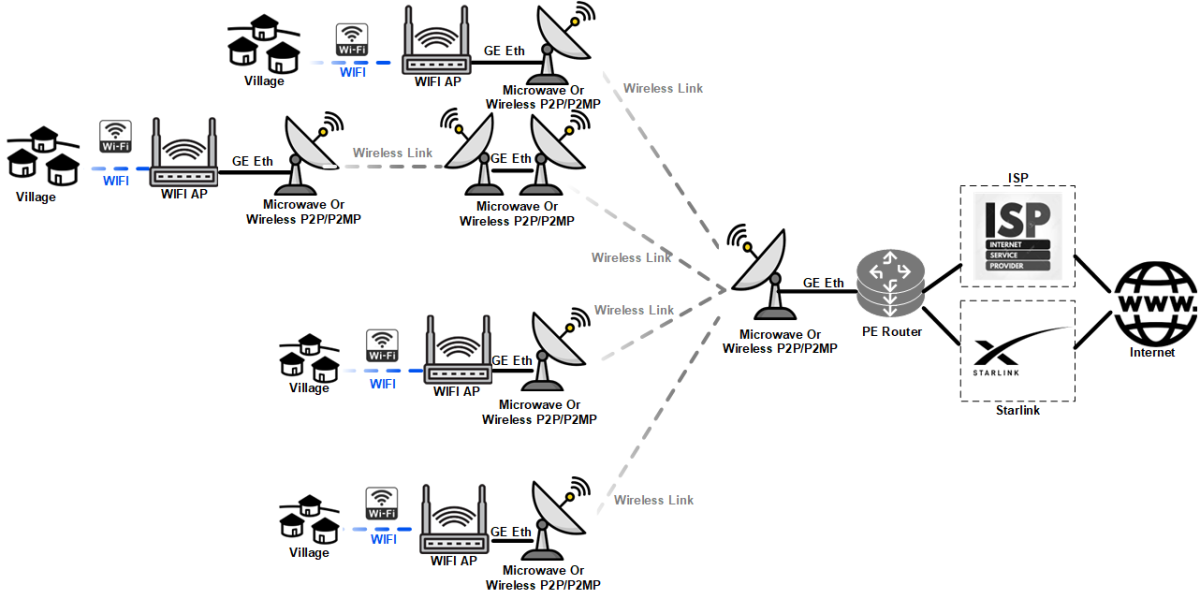
Using wireless P2P/P2MP and WIFI to provide rural broadband Internet is also a relatively effective option. This solution is more suitable for villages and towns with particularly low population density because it has lower construction costs and is simpler to operate and maintain.
ISP and Central Office
This scenario is usually more difficult to find a suitable ISP to provide service, Starlink is a more accessible Internet provider.
Central Office to Distribution Node
There is no optical fiber between the central office and the distribution node, so microwave and wireless P2P/P2MP are generally used.
Intermedia Node
Due to the distance limitation of Wireless P2P/P2MP technology, there are many cases where relay stations may be needed to extend the transmission distance.
Access Node
The target customers of this network architecture are often villages with low population density. In this scenario, the access node usually only needs a back-to-back connection between the WIFI AP and the Wireless P2P device.
Final User
End customers use their own smart phone, pad or computer to connect to the Internet via WIFI.
4.2 Advantages of Wireless P2P/P2MP and WIFI
The wireless P2P/P2MP and WIFI solution has the following benefits:
Easy Site Installation
Site construction is relatively simple, and the equipment is generally light and easy to transport to remote areas.
Low CAPEX investment
Compared with 4G small cell solutions or traditional fiber solutions, the cost is much lower.
Low operation and maintenance cost
The equipment of the user access station is cheap and easy to locate problems, which can be done by ordinary junior engineers. It is also simple to replace spare parts. The overall operation and maintenance cost is greatly reduced.
4.3 Solar Power or UPS Power for Wireless P2P/P2MP and WIFI
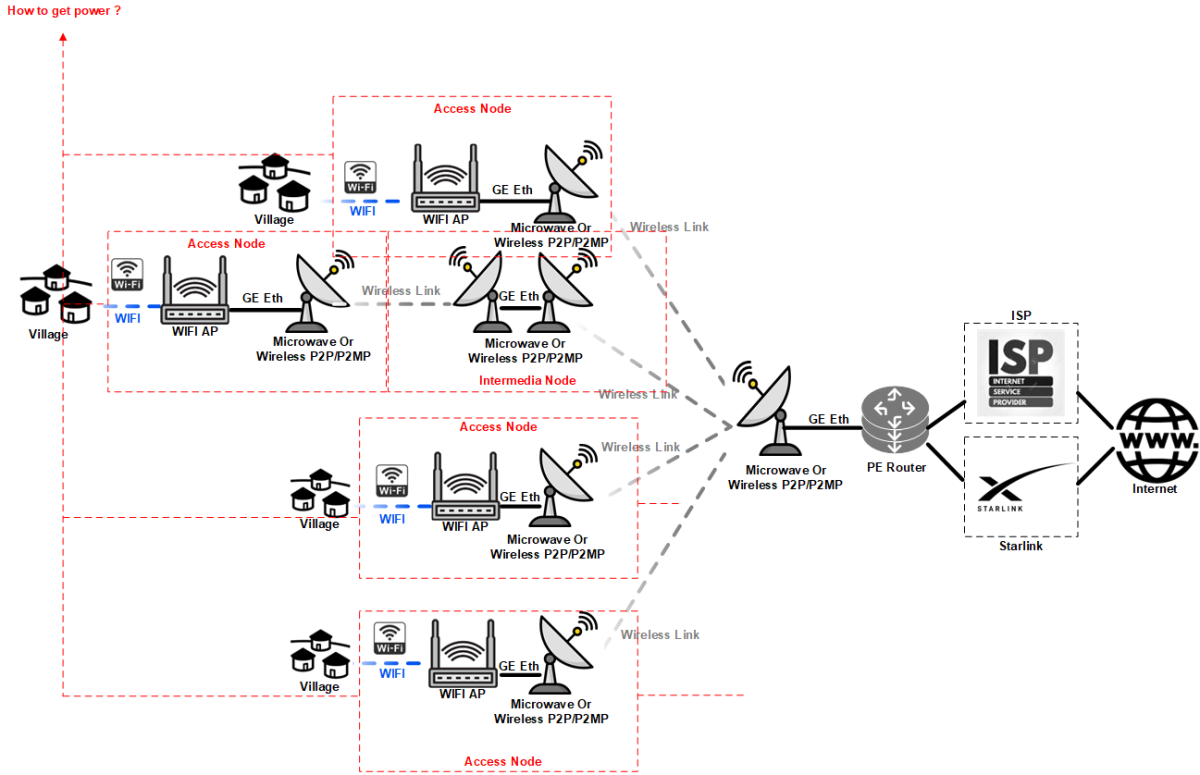
For the wireless P2P/P2MP plus WIFI solution, the pressure of building a power solution is actually much less than that of 4G small cell. This is because neither WIFI AP nor Wireless P2P/P2MP equipment is a high power consumption device. Let’s analyze the power requirements under this network architecture.


We can see that the power consumption of typical Wireless P2P/P2MP devices is generally not high. For example, the Mikrotik 60GHz P2P antenna in the above picture has a power consumption of only 5W and is powered by POE/POE+. Other wireless P2P/P2MP devices are similar, and generally have the following characteristics:
Power consumption ranges from 5-50W
Powered by POE/POE+/POE++

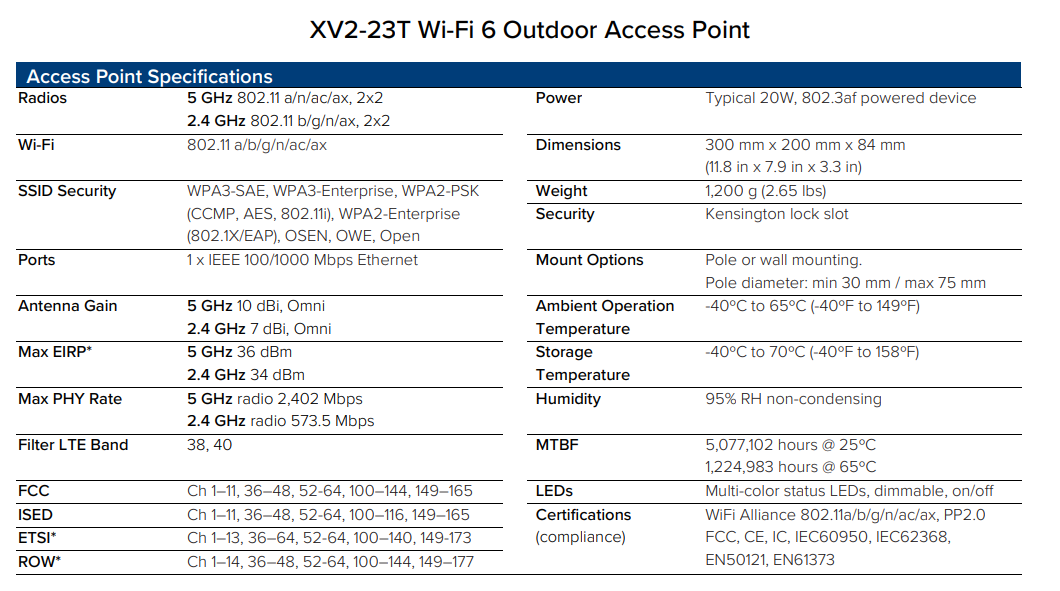
The above is an outdoor WIFI AP from Cambium network. We can see that its typical power consumption is 20W, and its power supply method is POE (802.3af). Generally speaking, outdoor WIFI APs have the following characteristics:
Power consumption ranges from 5-50W
Powered by POE/POE+/POE++
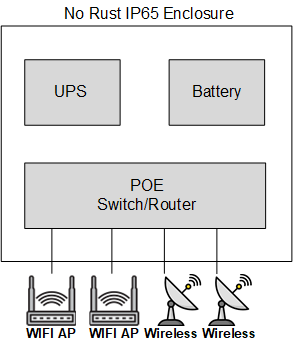
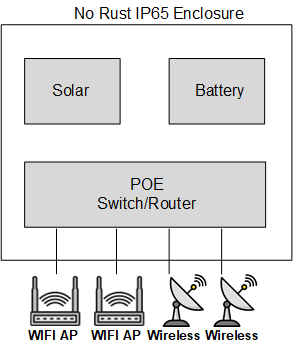
Rural Internet Connections based on Wireless P2P/P2MP and WIFI technologies have the same problems as 4G Small Cells:
(1) Equipment transportation is difficult because the site is remote.
(2) Installation and integration difficulties caused by remote sites
(3) Daily maintenance
We believe that the device that provides power for wireless P2P and WIFI should be an all-in-one, highly integrated device that does not require site integration. It is best to be lightweight and easy to install, integrating network and power. Above picture is a simplified model.
4.4 Edgeware Integrated Soluiton for Wireless P2P/P2MP and WIFI Based On UPS Scenario
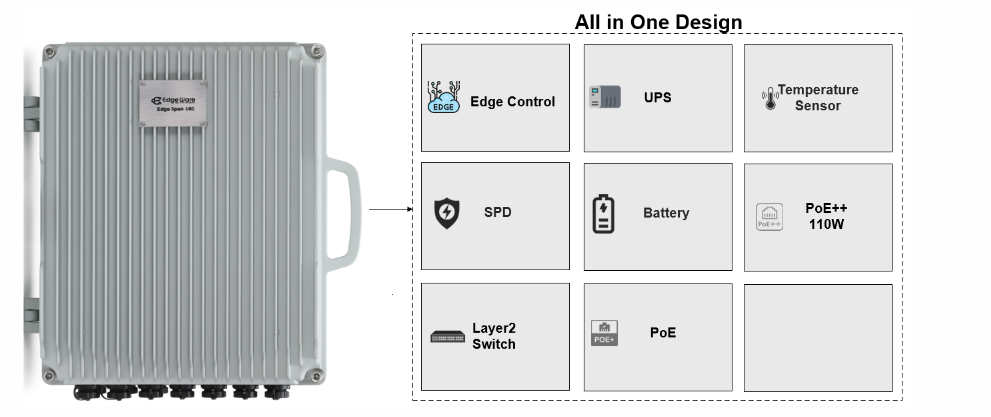
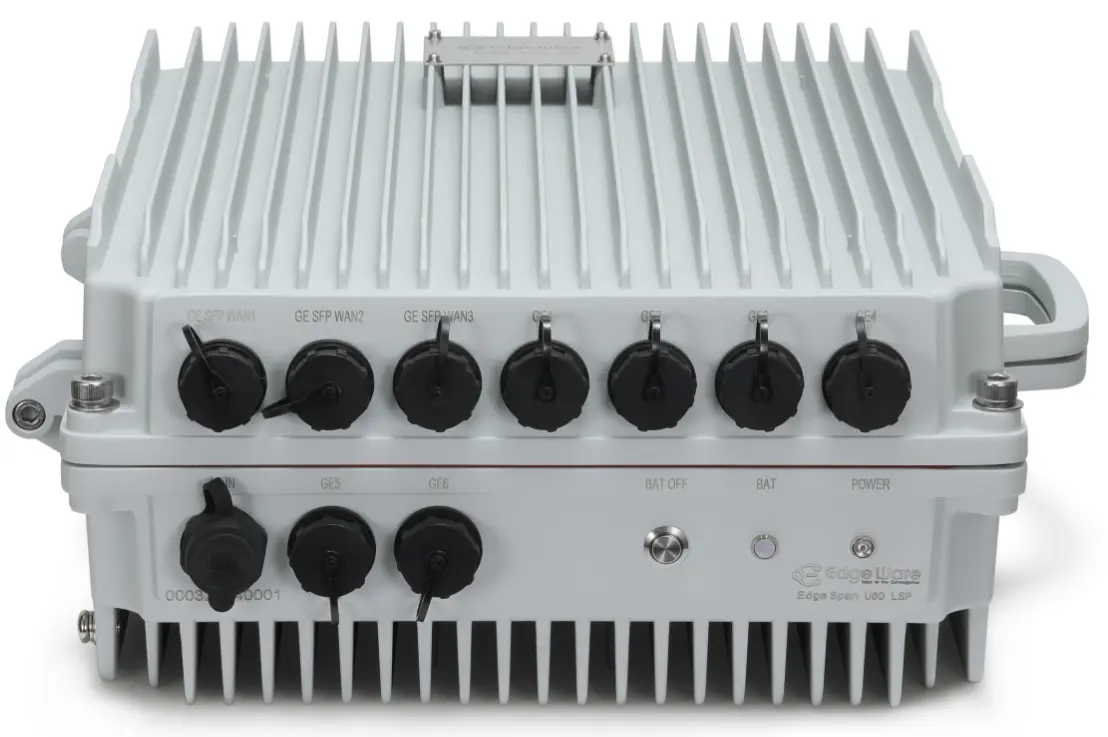
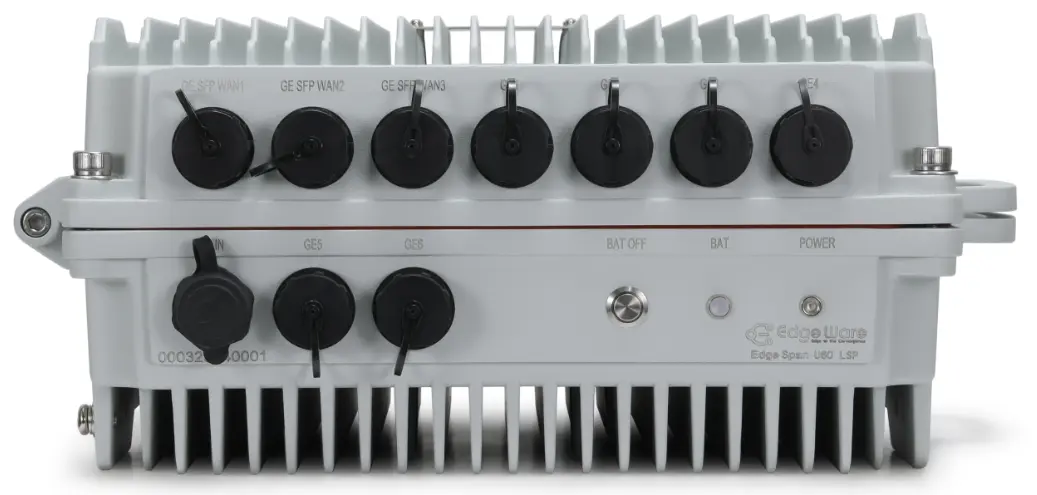
Edgeware’s Edge Span U60 series is an all-in-one system designed specifically for outdoor Wireless P2P/P2MP and WIFI scenarios based on UPS power. It is specially optimized for the deployment of Rural Broadband Internet and has the following features:
Based on the characteristics of rural areas that are difficult to transport and install, the highly integrated design makes the entire system small and lightweight.
No need for complex system interconnection, the whole machine is standardized when it leaves the factory, and plug and play is available at the site, thus avoiding complex installation and commissioning at the site.
The entire system is IP65 protected, the cast aluminum shell of the whole machine is completely rust-proof, and the whole machine is completely maintenance-free due to natural heat dissipation.
The system has a built-in Layer2 POE Switch module that supports POE/POE+POE++ standards, making it fully compatible with various outdoor wireless P2P/P2MP devices and outdoor WIFI APs.
Based on these features, Edge Span U60 can easily handle Rural Broadband Internet scenarios. For more information, please refer to the following link:
4.5 Edgeware Integrated Soluiton for Wireless P2P/P2MP and WIFI Based on Solar Power
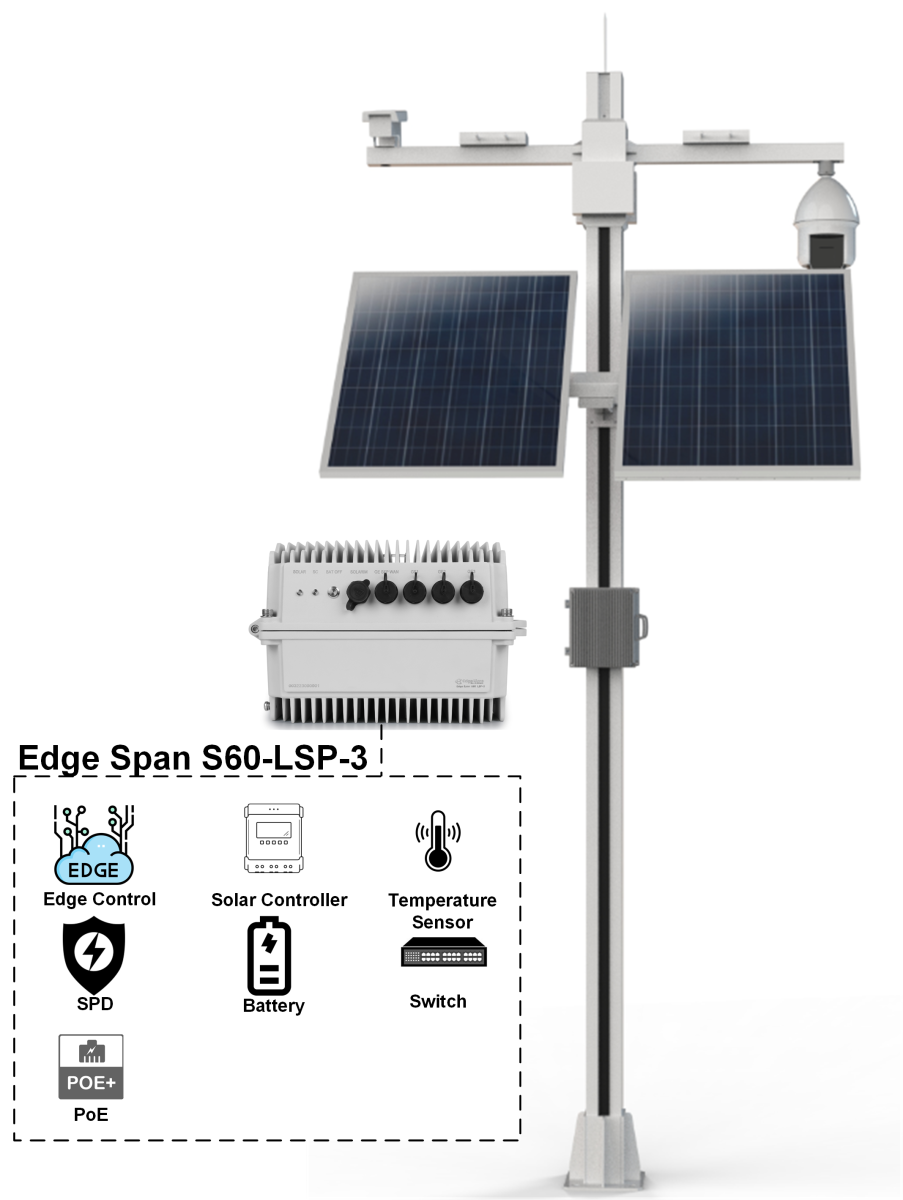
Edgeware’s Edge Span S60 series is an all-in-one system designed specifically for outdoor Wireless P2P/P2MP and WIFI scenarios based on solar power.It has all the features of the Edge Span series and the entire system is based on a high-efficiency MPPT solar controller
Based on these features, Edge Span U60 can easily handle Rural Broadband Internet scenarios. For more information, please refer to the following link:
5. Summary
In general, it is not impossible for Rural Broadband Internet to achieve profitability. The key lies in how to reduce operation and maintenance costs through network architecture design so that profitability can be achieved even with low revenue and low ARPU, thereby achieving more coverage and benefiting ordinary rural residents.

